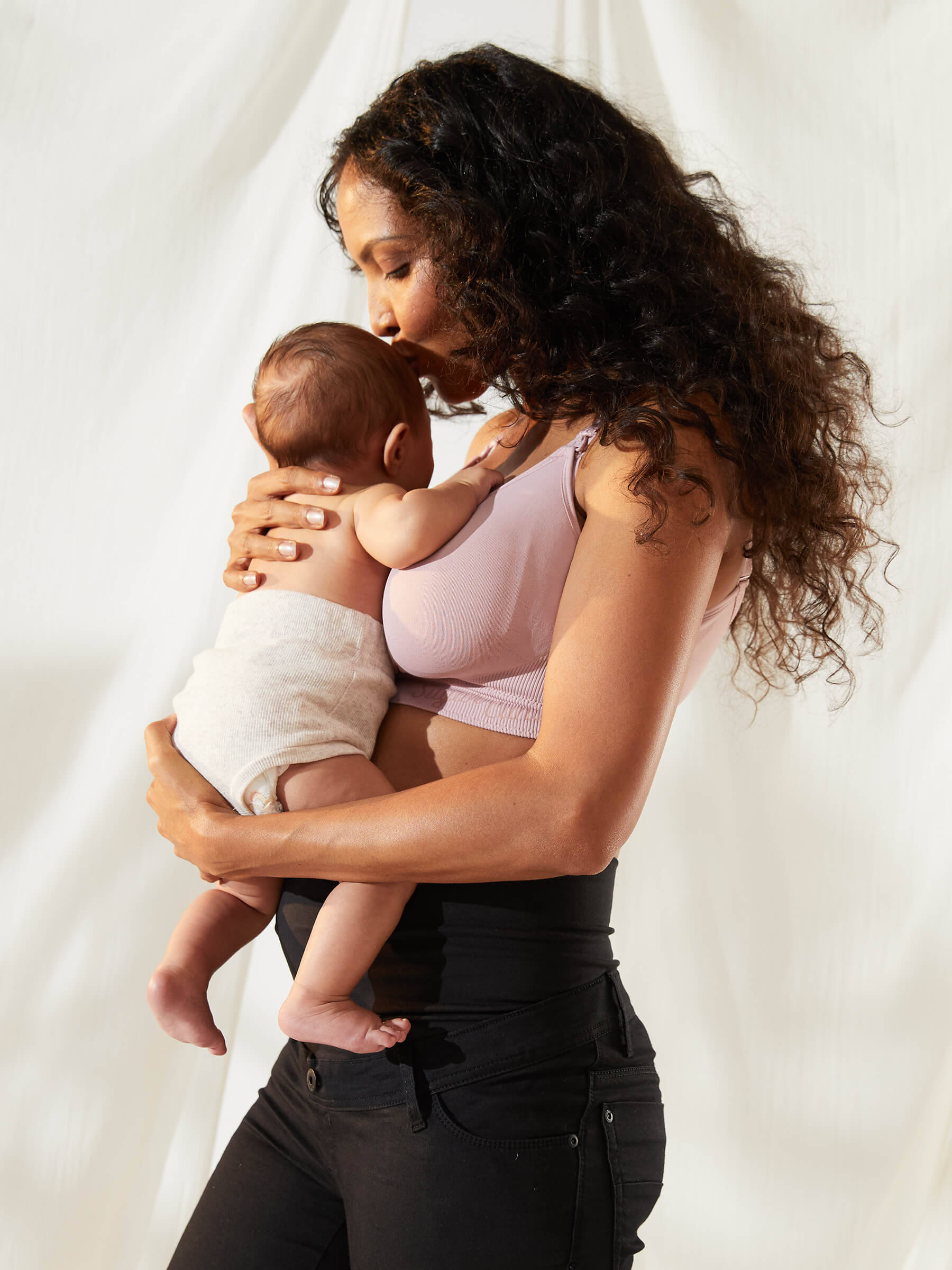A maternity or nursing bra is specially designed to provide support and comfort during pregnancy and breastfeeding, adapting to changes in your breasts and body. These specialised bras are crucial for comfort, support, and accommodating the significant changes in breast and body size and shape during this time. They help prevent discomfort, pain, and possible health problems that may result from wearing ill-fitting regular bras during pregnancy and breastfeeding.
Key Features of a Good Maternity/Nursing Bra
Good maternity/nursing bras prioritizes comfort, support, and ease of use during and after pregnancy. Key features include adjustable straps, supportive bands, soft and breathable fabrics, and easy-to-use nursing access. These features ensure comfort, prevent sagging, and facilitate convenient breastfeeding.
Physical Features:
- Adjustable Straps: Wide, adjustable straps distribute weight and prevent digging into the shoulders. The less amount of stretch, the better for support.
- Supportive Band: A wide band under the bust provides crucial support and stability.
- Soft, Breathable Fabric: Materials like cotton, microfiber, or bamboo wick away moisture and keep the wearer cool and comfortable.
- Seamless Design: Minimizes irritation and better for seamfree appearance under clothing, especially important during pregnancy and breastfeeding.
- Wire-Free: Wire-free bras offer comfort and flexibility, accommodating changes in breast size.
- Easy Nursing Access: Drop-down cups or pull-aside nursing allows for convenient breastfeeding.
- Double-layered Cups: Offer extra support and flexibility for changing breast sizes, enhance comfort for sensitive nipples, and minimise the show-through of nipples and nursing pad’s outlines.
Usability Features:
- Easy to Use: Nursing closures should be simple and accessible with one hand. Putting them on should also be simple with easy to use hooks and eyes.
- Easy to Clean: Durable fabrics and construction allow for easy machine washing and drying.
- Versatile: Bras should be suitable for various outfits and occasions, whether this be a sports bra that can handle high impact, a sleeping bra with wicking pockets for your nursing pads to keep them in place, a plunge lacey bra for date night or just to make you feel sexy again, or just an everyday t-shirt bra to keep you supported through the day.
Performance Features:
- Support: Provides adequate support for changing breast size and weight, preventing sagging.
- Comfort: Offers all-day comfort without digging, pinching, or causing irritation.
- Durability: Should withstand frequent washing and wear without losing shape or support.
- Breathability: Allows for airflow and prevents overheating, especially important during pregnancy and breastfeeding.
- Flexibility: Accommodates fluctuations in breast size and shape.

How to Choose the Right Size
Choosing the right bra size is crucial for comfort, support, and even posture. A properly fitted bra minimizes discomfort and potential health issues like back pain, while an ill-fitting bra can cause a range of problems. A professional fitting is recommended, but accurate self-measurement can also help. Bra fit should be assessed regularly, especially during significant life changes.
Importance of Professional Fitting:
A professional fitter can assess your individual breast shape and size, considering factors that self-measurement might miss. A well-fitted bra provides optimal support, reducing pressure on your back, shoulders, and neck. These bras are especially helpful during the second and third trimesters.
To maintain proper support when professional fittings aren’t available, wearing a multi-cup size bra is a good strategy, ensuring a better fit and support if you’re unsure of your size or if your size is changing, which is common during pregnancy and breastfeeding.
Wearing the right size helps prevent or ease pain caused by inadequate support, such as shoulder, back, and breast discomfort. It can also lessen the risk of ligament damage that may lead to sagging.
Self-Measurement:
- Underbust Measurement: Wrap the tape measure snugly around your ribcage, directly under your bust, ensuring it’s parallel to the ground and not too tight.
- Bust Measurement: Measure around the fullest part of your bust, keeping the tape measure level and comfortable.
- Finding Your Size: Enter your measurements in the fitting guide to ascertain your size.
Signs of a poor fit:
- Band Riding Up: A bra band that rides up in the back indicates it’s too loose or too small.
- Cups Gaping or Spilling: Gaps in the cups suggest the cup size is too large, while spillage or ‘double boobing’ indicates it’s too small.
- Underwire Digging In: Underwire should sit flat against your ribcage without digging in or causing discomfort, even if it is a flexible one.
- Constant Adjustments: If you’re constantly pulling up your bra or adjusting straps, it’s a sign of poor fit.
- Discomfort: Any pain or discomfort while wearing a bra is a strong indication of an ill-fitting bra.

Types of Maternity/Nursing Bras
Maternity bras come in various styles to accommodate the changing needs of pregnancy and breastfeeding. These can be cup and band sized, or multi cup fit, or can fit a number of different sizes.
Here’s a more detailed look at different styles:
- Seamless: These are often made from stretchy fabrics that adapt to changing breast size and provide a smooth, comfortable fit under clothing. They are a great option for all-day wear.
- T-shirt bras: Designed to be discreet under clothing, these bras offer a smooth, molded cup that provides a seamless look under t-shirts and other fitted tops.
- Lacey: For those seeking a touch of femininity and style, lace maternity bras provide a pretty and supportive choice. These can be wireless or underwired, with or without padding.
- Plunge shaped: These bras are designed to create a flattering neckline and are often a good choice for wearing with low-cut tops. These can be padded, seamless, with or without wires.
- Sports Bras: These offer extra support and comfort during physical activity, with features like wider straps and supportive bands.
- Bralettes: A comfortable, lightweight option for everyday wear, bralettes offer gentle support and a relaxed fit.
- Pumping Bras: The type of pump you’re using will determine what kind of pumping bra you’ll need, depending on whether it’s a flange or portable in-cup pump.
- Nursing Bras: While maternity bras focus on support and comfort during pregnancy, nursing bras are designed for breastfeeding, with features like drop-down cups or clips for easy access. All of our bras combine both maternity and nursing features.

When to Start Wearing a Maternity/Nursing Bra
In the first trimester, your breasts may increase in size and sensitivity. We recommend wearing a seamless bra during this stage, as your developing milk ducts are preparing for breastfeeding. Therefore, a no-wire policy should be followed.
In the 2nd and 3rd trimesters, it’s okay to revert to a flexible wired style or a cup and band size option, as most of your breast growth has occurred and the expansion of your underband will need extra hooks and eyes to accommodate this.
Immediately after you’ve had your baby, your milk will come in and your breast size can dramatically increase and possibly engorgement. For the first 6-8 weeks thereafter, we recommend a seamless bra again to be able to handle the fluctuations and support you comfortably during this time.
After 6-8 weeks, your milk flow will regulate, allowing you to return to your flexible wired or cup-sized bra. Most mothers still prefer their multi-sized bras for added comfort.
Additional Considerations
Your daily activities and overall lifestyle determine the type of bra or bras you will need. Other factors, such as your bra size, preferred style, and budget, will also influence your choice.
A good maternity or nursing bra plays an essential role in providing comfort, support, and convenient access for breastfeeding mothers. It is important to prioritise your personal needs when selecting a bra, taking into account the physical changes your body undergoes during pregnancy and postpartum.
Additionally, choosing a bra that adapts to your lifestyle—whether for everyday wear, exercise, or special occasions—can greatly enhance your comfort and ease of breastfeeding. Remember that the right undergarment not only supports your physical well-being but also helps you feel confident and comfortable as you nurture and care for your baby.

Katie is the proud mum of two beautiful girls and has been responsible for all the designs, style and fit at Cake Maternity for over a decade now. Katie is a nursing bra specialist and a fit, pattern and grading technician. She is passionate about breastfeeding and the many benefits it offers to both mum, baby and the environment.
She is determined to make the breastfeeding journey a comfortable, supportive and beautiful one for all mums, understanding that it doesn’t always come easy to everyone. That’s why she has made it her mission to empower women as they mindfully navigate the world of motherhood and help make breastfeeding easier, through experience-driven innovation.
Disclosure: collaborative post
Thank you for reading – if you enjoyed this content, please consider buying me a coffee here
or browse my Amazon wishlist
I really appreciate your support and it helps to keep the site running and for my time 🙂
Disclaimer: This content was automatically imported from a third-party source via RSS feed. The original source is: https://midwifeandlife.com/what-makes-a-good-maternity-nursing-bra/?utm_source=rss&utm_medium=rss&utm_campaign=what-makes-a-good-maternity-nursing-bra. xn--babytilbehr-pgb.com does not claim ownership of this content. All rights remain with the original publisher.



